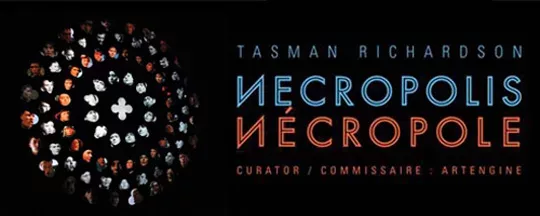
Necropolis is a vast media installation, a memento mori which encapsulates a decade of video experiments in a tactile and immersive environment. Four works with context-specific interconnected spaces shrink and wind through darkness. Artworks extend beyond the frame, transforming the shadows and intangible nature of dead recordings into an atmospheric, spatial experience for the living.
Galleries and museums are not places of the moment. They are, essentially, built for the past; they are houses for the artifacts of action. Contemporary artists are often challenged by this. They strategize to find a place for the present in spaces designed to organize and stabilize the past. They confront this past with a blooming and tumbling array of expressions of the now, but inevitably the representation of the present seems an impossible task. How can you hold on to the present for display? How do you represent the moment of now?
Tasman Richardson has not specifically set out to represent the present. He has instead set out to consider two key representational media of the past century, namely television and cinema or video and film. It is actually difficult to decide which terms to use to describe his focus. If we say his concern is with television and cinema it does not immediately direct our attention to his detailed engagement with the technologies of these media. However, to say video and film emphasizes the technological elements of the media rather than his passionate consideration of their content. Perhaps it is best said that this work is about television and cinema and video and film. Together they are a complement of “dead media” for him, manipulations of light and technology capturing and representing all manner of ghosts. Despite this preoccupation with the dead, Necropolis is not a museum within a museum housing the ghosts of cinema and television. Although it turns towards the past, a remarkable and undeniable experience of the present emerges.
What is the present, this “now”, you might experience in Necropolis? This is a very complicated question. At first it seems that Richardson has removed the narrative we often associate with moving images, and deployed an overwhelming level of stimulus to force you into the present. You become unable to consider either past or future and there is only the sensation of now. However, the process of bringing you into the “now” is much more carefully crafted (and hopefully more profound because of it). A representation of the “now” begins with an understanding of our experience of time in cinema and television. The time of cinema and television is an abstraction we now barely recognize as an abstraction, and Richardson substitutes these accepted abstractions of time (jump cuts, zooms, time-lapse sequences and montages) with another set that rely on looping, spatializing and multi-channel composition. In other words Richardson has replaced the compression of time we are accustomed to with an elongation of the “now” which destabilizes us. The experience of Necropolis is more than simply loud or bright, but is to be overwhelmed layer upon layer of a media present.
Despite the assertion above, it is equally true that Necropolis is not about the present. The remarkable experience of the “now” in Necropolis is, at least partially, achieved by precisely this truth, that it is about the past. This is perhaps what is most successful about Richardson’s approach, through a focus on the past it reveals something essential about our experience of the present. The present is not a discrete flowing moment between the past and the future. The present, the moment of now, is a very complex layering of time; it is overlapping moments of the immediate past and the impending future into a fluid space of the present that is key to our understanding of beautiful human expressions like melodies or sentences. Can we see how this fluid space of the present emerges in Necropolis? Here, as in much of his practice, Richardson is at play in fragments of cinema and television. The title suggests he views these media as ghosts of the past, or as the title, Necropolis, more explicitly references, as a kind of elaborate tomb for the dead. He layers their ghosts around you. He narrows the focus of these images of the past. He manipulates them into fractions of seconds. He saturates the everyday now we enter with, until the fragments of cinema and television replace our immediate present with their ghosts.
Tasman Richardson’s life is video and its many expressive incarnations. His practice ranges from live performances to immersive installations. Most often, it takes the form of collage through a process he established in 1996 known as JAWA, whereby musical compositions and visual narratives are created entirely through rhythmically edited appropriated video clips. Richardson has exhibited on nearly every continent, including his live performance Firing Squad at the London Art Fair (2014), and his solo exhibition Lethe Baptism at Neubacher Shor Contemporary in Toronto (2014). He was honoured as the feature artist at Calgary’s Particle + Wave festival (2015) and has two works in the National Gallery of Canada’s permanent collection. His home base is Toronto.